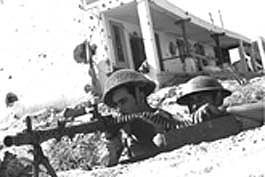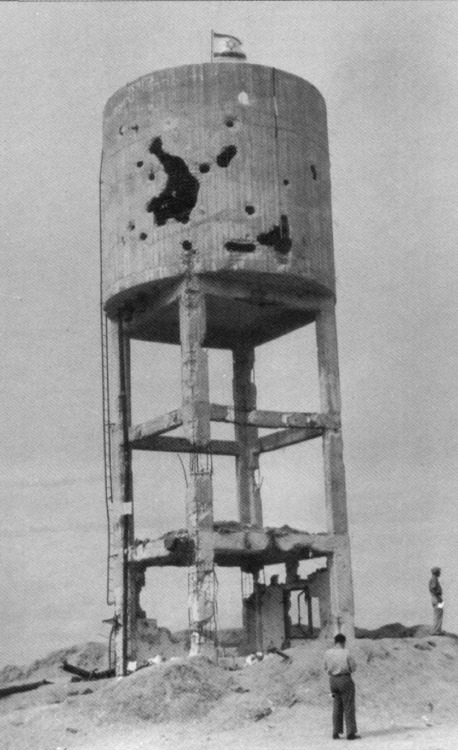After the First World War the British had taken over governance of most of the middle east, and slowly in the 1920's and 1930's the nations there became independent. After the Second World War the British having bankrupted themselves fighting Germany were slashing the number of military forces they maintained to save money, and so stated to speed up the plans to grant independence to Middle Eastern countries. One such area was the Mandate of Palestine.
During the preceding months before the end of the Mandate, anarchy erupted between the Jews and the Arabs. Many people on both sides were killed in the run up to the British withdrawal. Despite peace talks the situation became worse. Then on the 14th of May, 1948, the British Mandate ended. On the same day the Jewish leaders declared Independence of the state of Israel. The next day the Arab nations invaded. Today we shall have a look at one of those battles.

In the months running up to May 1948 unrest was so bad that most villages in Palestine had quite a large amount of defences and weapons. Equally the roads were very dangerous. The Palmach, fore runner to the Israeli Defence Force, ran supply convoys to many settlements. During the Passover holiday one such convoy reached the settlement of Yad Mordechai, bringing with it Matzo bread, as well as seven Czechoslovakian rifles for the inhabitants. This brought the defenders supplies of weapons up to 37 Rifles, four Sub-machine guns, two machine guns, two light mortars and a PIAT with three rounds.
The settlement itself was aligned South-west to North-east along the main road to Tel Aviv. Its defences were a central command post linked by communications trenches to ten sandbagged sangers around the perimeter fence. The sangers were laid out in a rounded U shape, with the open side of the U leading to a banana plantation on the south west side of settlement. About 300m from the settlement, on the other side of the plantation was a large pillbox.
On May the 15th the Egyptian army crossed the border and began to attack towards Tel Aviv in an attempt to crush the fledgling Israeli state. Two forces totalling 10,000 men, with all the elements of modern warfare, tanks, artillery and air support, began pushing up the roads. Nirim and Kfar Darom were the first two Jewish settlements they came to. The Egyptians attempted to seize both but were held at bay by the defenders. As neither settlement was in their way, they bypassed both and pressed on.
On May the 18th a pair of Spitfires from the Royal Egyptian Air Force made a bombing raid on Yad Mordechai. Realising that they might now be in the front line two of the defenders got hold of a jeep and made a run towards the nearest settlement, Kfar Darom. In part as a reconnaissance, in part to help evacuate the wounded. As they approached they found large Egyptian forces building up. Realising that the Egyptians had to seize an take Yad Mordechai, the two returned with the news of the impending threat. During the night a Palmach convoy arrived and evacuated all the non-combatants from the settlement, leaving about 100 fighters to hold Yad Mordechai.
On the morning of the 19th the Egyptians started their attack, with an air strike. The planes showered the settlement with Incendiary bombs setting fire to fuel stores. The situation was made worse by artillery fire, which smashed the settlements water tower.
In the strong-point the seven men defending the position could see the Egyptian army advancing towards them. As they closed the defenders opened fire, throwing the first wave back. The Egyptians brought up armoured cars armed with two pounder guns and began to hammer at the bunker. The Israeli's feared the two pounders, as the shells were described by one veteran as "[...] the red hot shot broke up as it travelled thus forming a fire ball that came at them slowly and with a frightening roar". The defenders threw back the second, and a third assault by Egyptian infantry.
The Egyptians launched a fourth attack. By now the pillbox was peppered with holes, the defenders Thompson sub-machine gun was out of ammunition, and the Bren was so low on rounds it was firing single shots. With little more than rifles the defenders waited until the Egyptians had closed right up with the Bunker then showered them with hand grenades. Most of the force was halted, but a party had managed to flank the bunker, and get into dead ground. With very little ammunition and an increasingly worsening situation the leader of the strong-point ordered his men to retreat back into the settlement.
Following the defenders the Egyptians ran into Sanger's #1 and #2. Both had good fields of fire, but for maximum effect the Commanders ordered their troops to hold fire. When the Egyptians reached the perimeter fence a mere ten meters from position #1 the Israeli's opened fire. Causing heavily casualties. Some Egyptians were forced to take cover behind hte bodies of their fallen friends by the withering salvoes.
Already the defenders supplies of ammunition were getting alarmingly low, so the defenders sent out scavenging parties to collect ammunition from the fallen Egyptians, included in the hall were another twelve PIAT rounds.
The next morning the Egyptians launched a series of attacks on position #1 and #2. Two Infantry Brigades attempted to force the perimeter line. Eight times the brigades attacked, covered by artillery and armoured car fire. The Israeli's pair of 2" mortars kept the armoured cars back, but left a vicious infantry fire-fight. However the defenders managed to hold on and force the Egyptians to fall back. After the last attack was thrown back and evening fell, the Israeli's counted their casualties. There are conflicting reports as to the scale of casualties. One gives the figure of 12 killed and 24 wounded, the other 24 killed and 20 wounded. Either was a significant portion of the defenders manpower now out of the fight. However darkness brought help as well. About 30 Palmach fighters arrived with more ammunition. They also brought the news that radio reports intercepted by the Israeli's had claimed about 300-400 casualties on the Egyptian side.

For the next two days the Egyptians shelled the settlement, constantly. Point blank direct fire from the captured strong-point was also brought to bear along with the artillery fire. Smashing the trench lines the defenders relied upon. During the 22nd under cover of the bombardment the Egyptians managed to push an armoured column along the road. However the bulk of the force couldn't use the same route unless Yad Mordechai was captured.
The 23rd was the final day of the siege. In the morning the Egyptians launched a diversionary attack on Position #10 facing the road on the east side of the settlement. At positions #1 and #2 a smoke screen was laid. When it cleared the defenders could see universal carriers and infantry advancing towards them. The carriers easily smashed the perimeter fence aside, and Infantry advanced into the Israeli line, capturing position #1.
From the banana plantation came another threat. A small force of men and as single Vickers light tank MKVIB pushed into the settlement. As far as I can tell this is the last time a Vickers Light tank saw action. Tanks are difficult to fight in up close, and very disorientating to their crew. The Vickers tank stopped just inside the settlement and began firing its machine gun. Against this bulwark the Israeli's couldn't counter attack to re-capture position #1. They opened fire at the tank with their PIAT, but couldn't score an effective hit. Some defenders attempted to destroy it with fortified grenades. These were two hand grenades tied to a charge of TNT.
Suddenly the tank lurched forward, its crew obviously not relishing the idea of sitting there and being buffeted by the explosions. As it pushed further into Yad Mordechai it bent the defenders line back. Suddenly, as it approached a chicken coup, a defender rushed out and charged the tank. He threw a fortified grenade that detonated beside the drivers vision slit. The Tank ground to a halt. As the unnamed defender attempted again to charge the tank he was hit and killed by a burst of machine gun fire.
The Egyptians tried to recover the tank by towing it away with a second tank. They may have gotten it out of the battlefield, but the tank itself was captured after the war by the Israeli's at a location near Yad Mordechai.
With the tank gone the defenders were able to launch a counter attack that included bitter hand to hand fighting. The attack managed to throw the Egyptians back for a final time.
By now the defenders were almost utterly unarmed, with only a few of their rifles still having ammunition, and even then only a few rounds each. The defence positions were also utterly smashed, more akin to shell holes than identifiable fortifications.
Equally the defenders themselves were utterly exhausted. Having been shelled, bombed and in constant action for five days straight, with little water in the hot summer sun. Knowing the desperation of the situation that night the Palmach sent out a column of ten improvised armoured trucks with ammunition and extra manpower.
The convoy was ambushed before it got close to the settlement. Three of the trucks did make it, but they had not been loaded with supplies. Upon realising the situation the Palmach convoy commander evacuated all the wounded he could carry. Meanwhile knowing that they had done all they could the rest of the defenders abandoned their settlement and retreated to friendly lines.
That there were friendly lines to fall back too was the main success of the defence. Before the war the Israeli's hadn't thought they would be attacked from Egypt, and so hadn't deployed any forces facing their border. If Yad Mordechai hadn't held the Egyptians would have made a clean breakthrough right into the heart of Israel, and we would be living in a very different world. As it was, the five days of resistance allowed the Israeli Defence Forces to establish a blocking force, and the rest is history.




